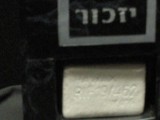Ρε ξεφτυλισμένε , σκουπίδι ,
εδώ λεμε ότι ΔΕΝ ΓΙΝΕΤΑΙ ΣΑΠΟΥΝΙ ΑΠΟ ΑΝΘΡΩΠΙΝΟ ΛΙΠΟΣ.
Τεχνικά.
Ξεφτυλισμενε.
Ποιός μίλησε για το ολοκαύτωμα;
κανείς δεν λέει ότι τεχνικά δε γίνεται (μόνοο οι νεοναζί αναθεωρητές)
η συζήτηση είναι σε τι κλίμακα έγινε
τη φωτογραφία την έβγαλα εγώ και το συγκεκριμένο σαπούνι είναι στο Εβραϊκό μουσείο της Βουδαπέστης
Human soap production at the Danzig Anatomical Institute during World War II
Testimony of Sigmund Mazur
During the Nuremberg Trials, Sigmund Mazur, a laboratory assistant at the Danzig Anatomical Institute, testified that soap had been made from corpse fat at the camp, and claimed that 70 to 80 kg of fat collected from 40 bodies could produce more than 25 kg of soap, and that the finished soap was retained by Professor Rudolf Spanner. Eyewitnesses included British POWs who were part of the forced labor that constructed the camp, and Dr. Stanisław Byczkowski, head of the Department of Toxicology at the Gdańsk School of Medicine. Holocaust survivor Thomas Blatt, who investigated the subject, found little concrete documentation and no evidence of mass production of soap from human fat, but concluded that there was evidence of experimental soap making.[13] Danzig was the German name of the now-Polish city of Gdańsk.
The recipe given by Mazur read, "5 kilos of human fat are mixed with 10 liters of water and 500 or 1,000 grams of caustic soda. All this is boiled 2 or 3 hours and then cooled. The soap floats to the surface while the water and other sediment remain at the bottom. A bit of salt and soda is added to this mixture. Then fresh water is added and the mixture again boiled 2 or 3 hours. After having cooled, the soap is poured into molds." [14]
Testimony was given both by Nazis and by British prisoners of war about the development of an industrial process for producing soap from human bodies, the production of such soap on a small-scale basis, and the actual use of this soap by Nazi personnel at the Danzig Anatomic Institute. [15][16][17]
Evidence does exists of small-scale soap production, possibly experimental, in the camp at Stutthof concentration camp near Danzig/Gdansk. [18]
Holocaust historian Robert Melvin Spector concludes that the Nazis "did indeed use human fat for the making of soap at Stutthof," albeit in limited quantity.[19]
In his book "Russia at War 1941 to 1945", Alexander Werth reported that while visiting Gdansk/Danzig in 1945 shortly after its liberation by the Red Army, he saw an experimental factory outside the city for making soap from human corpses. According to Werth it had been run by "a German professor called Spanner" and "was a nightmarish sight, with its vats full of human heads and torsoes pickled in some liquid, and its pails full of a flakey substance - human soap".[20]
[edit] Postwar
The idea that "human soap" was manufactured on an industrial scale by the Nazis was published after the war by Alain Resnais, who treated the testimony of Holocaust survivors as fact in his noted 1955 holocaust documentary movie Nuit et brouillard. Some postwar Israelis also referred disdainfully to Jewish victims of Nazism with the Hebrew word סבון (sabon, "soap").[21]
Mainstream scholars of the Holocaust consider the idea that the Nazis manufactured soap on an industrial scale to be part of WWII folklore.[22] Among others this view was held by the reputable Jewish historians Walter Laqueur,[23] Gitta Sereny,[24] and Deborah Lipstadt.[25] The same view was held by Professor Yehuda Bauer of Israel's Hebrew University and by Shmuel Krakowski, archives director of Israel's Yad Vashem Holocaust center.[1][2][3] However, historian Yisrael Gutman is very specific, stating that "it was never done on a mass scale."[26] And Holocaust historian Robert Melvin Spector concludes that the Nazis "did indeed use human fat for the making of soap at Stutthof," albeit in limited quantity.[27]
Today Holocaust deniers employ this controversy to cast aspersions on the veracity of the Nazi genocide.[28]
[edit]













